“Bond. James Bond.”
With those famed words, the greatest single British contribution to cinema was born. A secret agent that has spawned a film series like no other. A character that is still as engaging today, after 24 films, as he was back when he dominated the global box office in the 1960’s. We all have our perception of Bond and those classic films, built around the long legacy of the enduring franchise, but is the legacy of Bond different than what actually appears in the films? I’ll be going through the entire film series, one actor at a time, and looking at each film, exploring what works, what doesn’t, and the impact that film has had on the franchise. I’ve been a huge fan of the film series for as long as I can remember and I’m excited to find out if my childhood memories, back when the plots were well and truly secondary to the action and gadgets, hold up to when I watch the films today. Sean Connery is of course the first James Bond so that’s where I’ll begin, looking at his 6 films and skipping over On Her Majesty’s Secret Service which I’ll cover in the next instalment of this series.
Dr No (1962)
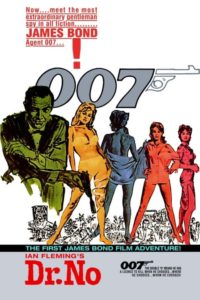
I look at the beginning of the James Bond franchise similar to the start of a TV show, where each film is an episode. In that case, Dr No is the pilot, if not the unaired pilot. The magic and the formula are almost there and briefly emerge at points, leading to some iconic moments, before disappearing within what is ultimately a detective film. Bond is less an action hero and more an investigator, sent to Jamaica to discover why a fellow agent has been killed. I do like the slower pace and more serious tone of Dr No but it often feels at odds with the sheer ridiculousness of the villain and his plot. For the majority of the film we get slow sequences of characters tailing each other or long conversations in offices with occasional action beats, whether they be brief car chases or Bond repeatedly hitting a spider with his shoe, but at the climax the film becomes what later Bond movies would embrace. We get a silly villain with some sort of physical abnormality (Dr No has solid metal hands that he’s somehow able to control) and an under-explained plan about an atomic laser (don’t ask) that will disrupt space rockets.
Highlights include Honey Ryder, the very first Bond girl, who sadly does absolutely nothing in the film but look pretty (she’s in a cell waiting for James to rescue her at the film’s conclusion) and the discussion between Bond and Dr No at dinner which feels like the most ‘Bond moment’ in the film, especially with the set up of the criminal organisation SPECTRE. The budget of the film was an issue and restricted the action to merely one location rather than the globetrotting adventures that are to come and you can tell most of the money went on the final action set piece, which is a lot of fun. Dr No is an interesting villain but his motivations are vague to say the least and we see little of him considering he’s the film’s titular character. The one constant is Connery as Bond who is the character we know and love from the first frame. He’s charming at the poker game and surprisingly brutal when he coldly executes the treacherous Professor Dent, an act that sets him up as a more brutal character than he would become in the later iterations. Despite Connery nailing the role instantly, the film feels uneven, missing that spark and is very much ‘proto-Bond’.
From Russia with Love (1963)
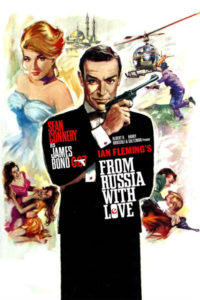
As odd as it sounds, most of my love for From Russia with Love comes from playing the PlayStation 2 video game which I completed over and over again when I was younger. The film isn’t bad either. In fact, it’s pretty amazing. If Dr No was the Bond pilot then this is most definitely the series premiere. All the elements of the Bond franchise are on display, from the opening credits that are projected onto the bodies of dancing women (the great Matt Munroe theme song is bizarrely played over the end credits) to the inclusion of Q and the gadgets which will become a vital part of the Bond formula. The tone of the film is probably the most serious out of all the Connery films and while Dr No dabbled in the ridiculous, From Russia with Love plays it straight throughout. It’s a classy, glossy and grounded Cold War thriller and by far the most complex Bond film of the era.
It’s also Connery’s finest performance as James Bond, with him caught in a game between both sides as he tries to acquire a code-breaking device from a Russian defector while being hunted by a SPECTRE operative played by Robert Shaw. SPECTRE returns, bringing with it the first appearance of Blofeld and the first pre-credits scene of the franchise where Shaw’s character Grant hunts a man dressed as Bond. Grant is a great villain. A rare adversary who can match Bond’s combat prowess and is finally dispatched in the legendary fight aboard the Orient Express. While I feel we spend a little too much time on the train, it’s a great way of keeping the budget down with the action being confined to a small set while also seemingly making the film be an exotic globetrotting adventure. Even if the Italian boat chase finale was clearly filmed in the UK. From Russia with Love took what worked in Dr No and improved upon it in every way and is perhaps Connery’s best film. Bond has arrived, but that classic Bond tone has still not been perfected.
Goldfinger (1964)
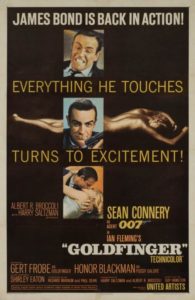
It’s Goldfinger that manages to nail that perfect blend of realism and ridiculousness that has made the Bond franchise what it is today. While From Russia with Love is Connery’s best, Goldfinger is the most important of his films and offered the framework all other Bond films would follow. The entire film is iconic whether it’s the song, the first sight of Q Branch, the Aston Martin DB5, Goldfinger’s henchman Oddjob or the classic “Do you expect me to talk?” interrogation-by-laser scene. The film introduces the pre-credits action scene of Bond on a separate mission that’s unrelated to the rest of the film and while Dr No felt tonally unbalanced, Goldfinger can go from grounded action and Golf-course conversations to a plot involving detonating an atomic bomb in Fort Knox to irradiate the world’s gold supply and somehow it works.
However, I am a little disappointed that Goldfinger (the titular villainous businessman) was never connected to SPECTRE, making this the only Connery film in which the organisation doesn’t appear and Bond forcing himself on Pussy Galore, an implied gay character, is not one of the franchise’s best moments. John Barry’s music for Goldfinger is sensational and successfully manages to bring in the melody of Shirley Bassey’s theme song into the score. I’ve yet to mention the James Bond theme but do I have to? It’s iconic in its own right although it is used at strange times in the early films. It just starts blaring out when Bond is unpacking in his hotel room in Dr No and it’s not used perfectly until You Only Live Twice. Goldfinger sets the rules of the Bond franchise and while not the best film of the bunch, it’s the one with the foremost influence on the franchise.
Thunderball (1965)
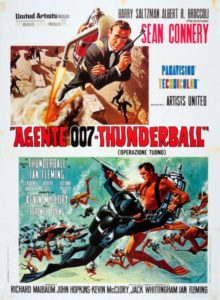
And then, after three of the most famed films of British cinema, we get Thunderball. I never gravitated towards Thunderball when I was younger but I never knew why. Now I do: it’s boring. Connery’s performance can do little to steady the ship and many of the film’s issues stem from one place: the budget. The first three films had budgets that, although they were quite high for the time, restricted the producers from doing anything particularly extravagant. However, with the proven success of the series, Thunderball was given a massively inflated budget (9 times that of Dr No) and the whole film suffers from it. There is a good film in there somewhere, revolving around SPECTRE agent Largo stealing nuclear weapons from a downed Vulcan Bomber, but it’s surrounded by so much bloated material and self indulgence. The film is far too long at 130 minutes and it’s 40 minutes in until we get Bond’s briefing with M. 40 minutes! The film was also released around the time filmmakers were able to shoot good quality underwater footage and the final act is just an excuse to show this off. The underwater fights go on for far too long and you can’t differentiate any of the characters. It’s just masked men slowly swinging knives at each other for 30 minutes.
I feel like Largo could have been a good villain, considering he’s SPECTRE’s Number 2, but he’s little more than an eyepatch and an accent. I do love seeing SPECTRE’s base of operations, complete with a board room meeting of all it’s members, before cutting back to London to see all the 00 agents meet up in a similar fashion. John Barry’s music is great too, although I’m not the biggest fan of Tom Jones’ theme song. I like character of Domino quite a bit; it’s nice to get a Bond girl who has some agency. Having said that, the sexual politics of the film are problematic by today’s standards. Particularly the scene where Bond tells a woman he’ll make her lose her job if she doesn’t sleep with him. After the build in quality of the Bond series up to this point, Thunderball is a big disappointment, even more so than I remember. I may even enjoy the unofficial remake – Never Say Never Again – more, but you’ll have to wait until I cover that film in a few weeks time.
You Only Live Twice (1967)
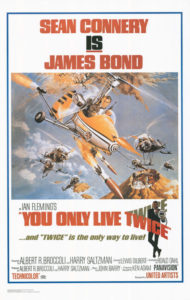
You Only Live Twice is pretty far from being the best Connery Bond film but it might be my favourite. At least it was when I was younger. I was, and still am, obsessed with Star Wars and so the opening scene of a space rocket swallowing another space rocket was pretty mind-blowing, especially when accompanied by John Barry’s incredible score. Bond travels to Japan, after faking his own death, to track down the origin of this mysterious space craft. It’s a really fun film with some great action set pieces, primarily the raid on the SPECTRE base in the finale and the “Little Nellie” helicopter chase, but it often becomes too silly. Donald Pleasence plays the most iconic version of Blofeld (Dr Evil scar included) and his performance is suitably bizarre and a great payoff of the last 4 films which had set up his character. Bond training as a ninja is great but the film takes an unnecessary detour when Bond has to become Japanese to go undercover. Bond is “transformed” and by that, I mean he wears a dodgy wig and has his eyes sellotaped back to make them look more oval-shaped. Watching today, you can do little but laugh at the sheer preposterousness of it all.
It’s the ultimate Bond mixed bag. Some great stuff, some good, some bad and some you wish could be cast from your mind. You Only Live Twice sows the seeds for the more silly and campy Bond going forward but the franchise doesn’t commit to that tone just yet. In fact, the film might have the best and most brutal fight choreography of any of the Connery films. A highlight is the fight Bond has against a henchman in a businessman’s office in which both men throw each other across the room in a shockingly severe way. Although even that scene is tainted by silliness because at one-point Bond picks up an entire leather sofa and uses it to jab at his opponent. Partway through production of the film was when Connery decided to leave the role due to arguments with the producers over his pay and unwanted media attention and that annoyance shows in the performance. He’s still good in the role but it’s clear he’s burnt out.
Diamonds Are Forever (1971)
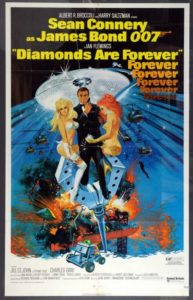
After the controversial On Her Majesty’s Secret Service (which I’ll cover next time), Connery was given a huge amount of cash to return to the role for one last time in what is undoubtably his worst film. The opening sequence is quite effective and sees Bond, whose face remains unseen, travel the world searching for Blofeld to get revenge on him for killing his wife. The reveal of Bond’s face is a cool way to announce Connery’s return to the role but the film soon takes a wrong turn. The plotting is overly convoluted and messy when Bond pretends to be a diamond smuggler to investigate a long chain of smugglers who work for Blofeld and are being killed off one by one. And then what does it all lead to? A giant space laser! The go-to villain plot if you can’t think of anything interesting. Charles Grey is Blofeld this time around and can’t match Pleasence’s sinister delivery and instead just makes the character incredibly posh.
The camp tone that was seeded in You Only Live Twice takes full effect here with Blofeld disguising himself a woman which undercuts any menace the character might have developed. For some strange reason, Bond has a chase in a moon buggy across the Nevada Desert which is probably one of the worst action scenes in all of Bond. Even John Barry’s music, other than the Mr Wint and Mr Kidd theme, is a disappointment. Speaking of Mr Wint and Mr Kidd, it’s a shame that the only openly gay characters in the Bond film canon have their sexuality portrayed as such to make them seem a bit weird and quirky. They are memorable characters but not necessarily for the right reasons. After On Her Majesty’s Secret Service, the producers were desperate to try and get back to the feel of the more successful Bond films but this just made the film feel enervated. At this point, Connery and the franchise feel tired and in desperate need of a rejuvenation, a new direction rather than to try to capture the spirit of the old, and thankfully the next film, Live and Let Die, will most definitely bring that energy, along with a brand-new Bond: Roger Moore.
So, is Connery the best version of Bond we’ve seen onscreen? I’ve always been a Roger Moore kind of guy but upon this rewatch my admiration and enjoyment of Connery’s Bond has grown to new heights and I look on him as the definitive Bond, although I’m unsure if that’s purely because of his acting or if primogeniture plays a part.
Who’s your favourite Bond? Which is your favourite Connery Bond film? Let me know in the comments and geek out with me about TV, movies and video-games on Twitter @kylebrrtt and I’ll be back in two weeks time with an article dedicated to George Lazenby and his one and only Bond film: On Her Majesty’s Secret Service.




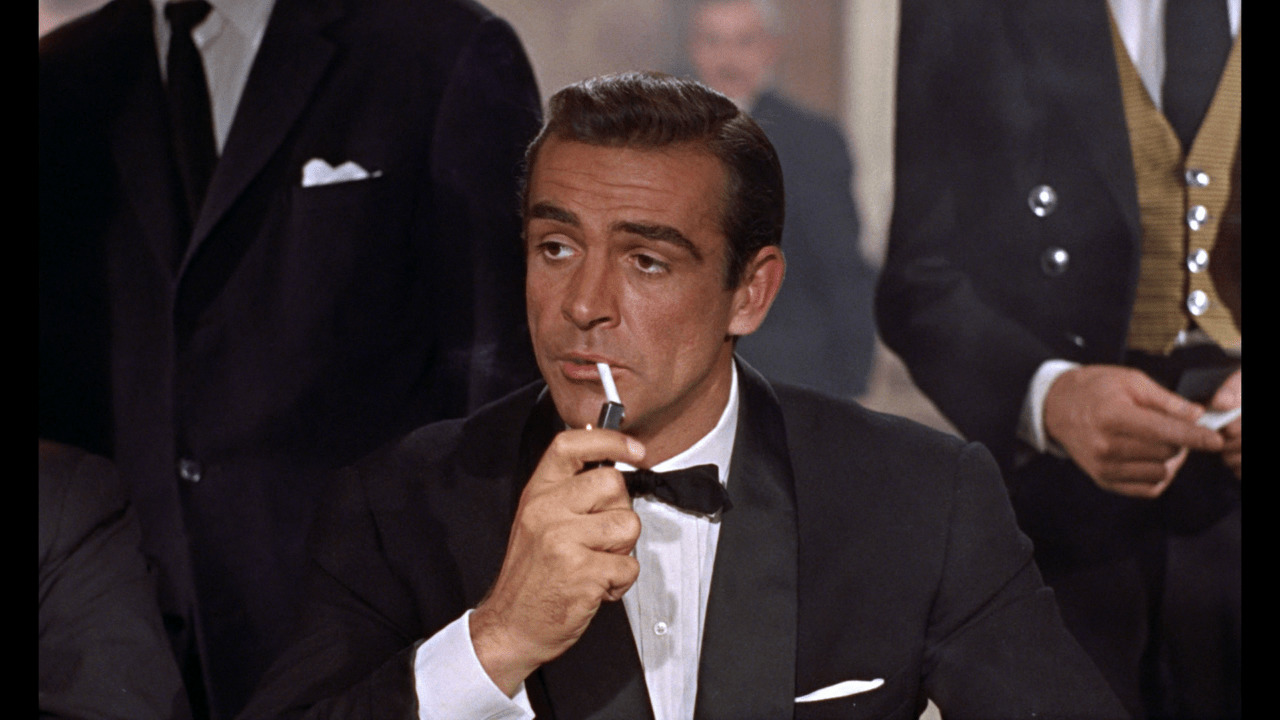




Well written Kyle